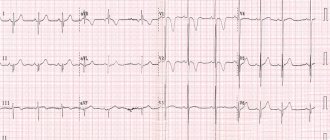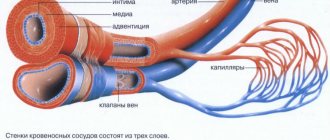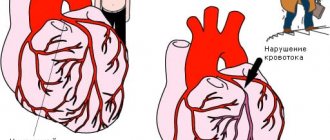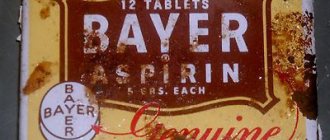The concept of “angina pectoris” combines various types of pain symptoms in the heart area, occurring mainly during intense physical activity. In medical terms, this is a sign of myocardial ischemia, which makes itself felt in attacks for 15-20 minutes and occurs when taking nitroglycerin. Symptoms may appear simultaneously or as isolated manifestations, which complicates the initial diagnosis. When the first warning signs appear, it is important to immediately seek medical help, because angina pectoris is a sure harbinger of myocardial infarction and indicates serious disturbances in the functioning of the heart muscle.
Classification and symptoms of angina
Depending on the symptomatic picture, there are:
- a stable type of disease that occurs in an unchanged form and requires the most serious treatment;
- unstable angina - the most dangerous, of a primary nature or each time making itself felt with new symptoms;
- angina pectoris is an invariable sign of increased physical activity;
- angina at rest has no clear cause and can manifest itself even during sleep, accompanied by a feeling of panic, suffocation, and a set of autonomic disorders.
Characteristic signs allow you to distinguish angina pectoris from other diseases of the heart muscle:
- pressing burning pain;
- recoil under the left shoulder blade, in the neck or arm;
- noticeable fluctuations in pulse and blood pressure.
Any signs of angina pectoris should be a reason to contact a specialized doctor to clarify the diagnosis and prescribe appropriate treatment.
Are you experiencing symptoms of angina?
Only a doctor can accurately diagnose the disease. Don't delay your consultation - call
Clinical picture
Main symptoms of the disease:
- Chest pain, which is characterized as pressing, squeezing, burning.
- Pain spreading to the neck, jaw, arms, shoulders or back.
- Shortness of breath, feeling of lack of air (cardiac asthma), pallor.
- Sudden and severe fatigue.
- Anxiety and worry.
- Nausea, dizziness, cold sweat.
It is important to differentiate between angina attacks and panic attacks that have similar symptoms. Common to these two conditions: chest pain, sweating, difficulty breathing. With a panic attack, the symptoms of rapid breathing and irrational fears, paresthesia throughout the body come first, and chest pain has an unstable, transient nature, while for angina pectoris the most common complaint is cardialgia with typical characteristics and duration of the painful episode.
Causes of angina
Long-term study of angina pectoris allows us to accurately name the physiological mechanism of the development of the disease. Due to nutritional and metabolic disorders, the lumen of the arteries gradually narrows due to atherosclerotic plaques. Deterioration of blood flow causes oxygen starvation of the heart muscle cells, which causes obvious and quite severe pain. At the same time, vascular spasm may occur, caused by nervous overstrain or hypothermia of the body.
The appearance and accumulation of atherosclerotic plaques on the walls of blood vessels is often provoked by:
- symptoms of arterial hypertension;
- smoking;
- obesity;
- symptoms of diabetes;
- physical inactivity, sedentary lifestyle;
- unsatisfactory food quality.
The process of reducing the lumen of the artery occurs gradually. When it narrows by 50% or more, the blood flow noticeably deteriorates, which leads to disturbances in the functioning of the heart muscle. Physical activity and psycho-emotional stress contribute to the aggravation of the situation, forcing the heart to work intensively against the background of oxygen starvation. Lack of oxygen causes malnutrition of muscle tissue, which causes a characteristic pain syndrome with signs of suffocation and pressure in the heart area.
Risk factors that trigger the process of vasoconstriction due to the formation of sclerotic plaques
When making a primary diagnosis, the specialist must take into account the possible effect of one or more of the following factors:
- hyperlipidemia – disorders of cholesterol metabolism with a simultaneous decrease in high-density lipoproteins;
- obesity caused by the predominance of animal fats and high-calorie foods in the diet against the background of a lack of cereals, vegetables, fruits and legumes;
- physical inactivity is a lack of movement that triggers the development of obesity due to the accumulation of cholesterol;
- arterial hypertension is a companion to coronary heart disease due to oxygen deficiency;
- anemia - a decrease in hemoglobin level against the background of general weakness of the body;
- type 2 diabetes mellitus, which is considered one of the most dangerous risk factors;
- tobacco addiction - helps to reduce the volume of oxygen in the blood, increases blood pressure and promotes spasm of arteries narrowed due to the accumulation of atherosclerotic plaques.
The action of at least two factors is sufficient for angina to become serious and require immediate intervention by a specialist.
Why is it important to see a doctor?
Even if there was only one attack, this is a sufficient reason to undergo diagnostics in a qualified cardiology clinic. Angina pectoris can lead to myocardial infarction and even death. Only an experienced cardiologist will promptly identify the problem and prescribe treatment that will help you avoid the fatal risk.
You will receive the full range of qualified cardiological services for the diagnosis, treatment and prevention of cardiovascular diseases at the CBCP Center for Circulatory Pathology, equipped with expert-class European equipment.
Methods for diagnosing angina pectoris
Laboratory and instrumental examination methods help to give the patient an accurate diagnosis. A blood test can determine:
- the level of total cholesterol and so-called lipid fractions;
- blood clotting indicators;
- glucose level;
- markers of systemic inflammation;
- the presence in the blood of other substances that affect cholesterol metabolism and the level of oxygen saturation in the blood.
Among the instrumental diagnostic methods, the following are of particular importance:
- ECG at the peak of an angina attack;
- daily ECG monitoring, which allows to identify abnormalities in the functioning of the heart in various external conditions;
- EchoCG – reveals ischemic changes and disturbances in the process of contraction of the heart muscle;
- bicycle ergometry - identifies the maximum level of load for the patient without the risk of symptoms of angina pectoris;
- stress echocardiography using ultrasound waves;
- computed tomography of the heart structure;
- coronary angiography - radiography with the introduction of a contrast agent.
Based on the results obtained, a treatment course is developed and a decision is made on surgical intervention.
Tests and diagnostics
There are several tests your doctor may use to confirm the diagnosis.
- Electrocardiogram (ECG). An ECG monitors the electrical signals that cause the heart to contract. Your doctor examines the patterns between heartbeats to look for changes in blood flow: whether it is slowing down, interrupted, or developing a heart attack.
- Stress test. Sometimes angina is easier to diagnose when your heart is working under load. During a stress test, you walk on a treadmill or pedal an exercise bike. Your blood pressure and your ECG readings are monitored during your workout.
- Echocardiogram. An echocardiogram uses sound waves to produce an image of the heart. Your doctor can use the images to determine if there are areas in your heart muscle that have been damaged due to poor circulation - the cause of angina. An echocardiogram is sometimes given during a stress test.
- Radionuclide stress test. The radionuclide stress test allows you to evaluate the blood supply to the heart muscle at rest and during stress. In this case, a radioactive substance is injected into the bloodstream and mixed with the blood. A special scanner that reacts to radioactive material scans the heart and creates an image of the heart muscle. Insufficient blood flow to any part of your heart will appear as a bright spot on pictures.
- Chest X-ray. This test takes pictures of your heart and lungs. X-rays can see if your heart is enlarged and can help identify other causes that might explain your symptoms.
- Blood tests. If your heart is damaged by a heart attack, some cardiac enzymes slowly leak into the blood. Blood samples can be tested to see if they contain enzymes.
- Coronary angiography. Coronary angiography uses x-rays to examine the inside of your heart's blood vessels. During coronary angiography, a special dye is injected into the blood vessels, which is recorded by x-rays. The X-ray machine quickly takes a series of pictures (angiograms), offering a detailed look at your blood vessels.
- Cardiac computed tomography (CT). For a cardiac CT scan, you must lie on a table that moves inside the scanner. X-ray tubes inside the machine rotate around your body and collect images of your heart and chest that can show whether you have abnormalities.
Treatment of angina
Since stenography develops against the background of coronary heart disease, it is important to eliminate the root cause of the disease in order to then cope with associated symptoms. At the same time, measures are taken to relieve pain and prevent new attacks.
First aid for angina pectoris is to take nitroglycerin, which reduces pain. A permanent treatment course focuses on taking anti-ischemic drugs, thanks to which the heart continues to work stably in conditions of lack of oxygen. Stenting and coronary artery bypass surgery allow the lumen of blood vessels to expand, restoring the conductive capacity of the arteries. Other clinical recommendations for angina pectoris are selected taking into account the patient’s condition, his age and the severity of cardiac pathology.
Rules for taking nitroglycerin
As part of first aid for an angina attack, you can use both tablets (to relieve an attack outside the home) and drops. The medicine is dropped onto a piece of sugar, which is placed under the tongue and wait until it dissolves. Check the dosage with your doctor, but remember: you cannot take more than 3 tablets (drops) in 15 minutes.
You may feel dizzy, because the effect of the medicine is to dilate blood vessels and reduce pressure. Therefore, before taking, take a comfortable position, sitting or lying down.
FAQ
Why is angina pectoris dangerous?
If the patient neglects his health and refuses medical care, the frequency of attacks may increase and the pain may intensify. A further decrease in the lumen can cause acute oxygen starvation and the development of myocardial infarction with a poor prognosis.
How to relieve an angina attack at home?
When the first sensations of pain appear, you should immediately stop working or moving, take a sitting or lying position, put a nitroglycerin tablet under your tongue, which should always be at hand. If your eyes darken and perception deteriorates, you should ask others for help. It is important to try to record the condition preceding the attack and the duration of the last one in order to report it to the attending physician.
How to determine angina?
Among the characteristic signs of angina pectoris are severe pressing pain in the heart area with a return to the peripheral parts of the body, noticeable fluctuations in pulse and pressure. The attack occurs with sudden physical or psycho-emotional stress and subsides within 15-20 minutes. Only the attending physician can carry out differentiated diagnostics and accurately name the cause of the disease.
First aid for an angina attack
If an angina attack occurs, you must follow the instructions received from your attending physician or (if there were no such instructions) follow the algorithm:
- Note the time of onset of the attack.
- Measure blood pressure, heart rate and pulse.
- Sit (preferably in a chair with armrests) or lie in bed with the head of the bed raised.
- Provide fresh air (free your neck, open a window).
- Take acetylsalicylic acid (aspirin 0.25 g), chew the tablet and swallow.
You should not take acetylsalicylic acid (aspirin) if you are intolerant to it (allergic reactions) and have already taken it that day, as well as if there is a clear exacerbation of gastric and duodenal ulcers.
6. Take 0.5 mg of nitroglycerin. If in the form of a tablet, put it under the tongue and dissolve; if in the form of a capsule, bite it, do not swallow; if in the form of a spray, inhale (inject) one dose under the tongue without inhaling.
If, after taking nitroglycerin, severe weakness, sweating, shortness of breath, or a severe headache appears, then you need to lie down, raise your legs (on a bolster, pillow, etc.), drink one glass of water and then do not take nitroglycerin.
You should not take nitroglycerin if you have low blood pressure, severe weakness, sweating, severe headache, dizziness, acute impairment of vision, speech or coordination of movements.
7. If the pain has completely disappeared and the condition has improved after taking aspirin and 1 dose of nitroglycerin after 5 minutes, limit physical activity and discuss further treatment with your doctor.
8. If the pain persists for more than 10-15 minutes, you must take nitroglycerin a second time and urgently call an ambulance!
ATTENTION ! If aspirin or nitroglycerin is not available and the pain persists for more than 5 minutes, call an ambulance immediately!
9. If pain persists even after taking the second dose of nitroglycerin after 10 minutes, you need to take nitroglycerin a third time. Wait for an ambulance.
Recommendations
To prevent angina attacks you must:
- quit smoking
- control cholesterol levels, if necessary, eat a low-fat diet
- perform a dosed and doctor-selected set of physical exercises
- avoid stress
- lead a healthy lifestyle
A balanced diet, dosed physical activity and regular monitoring by a qualified doctor can save a patient with angina pectoris from heart surgery.
Cytoprotectors
Cytoprotectors
– protects against the death of heart muscle cells during episodes of acute and chronic oxygen deprivation (ischemia), allowing the cells to produce energy to pump the heart using less oxygen.
There is an evidence base for the drug trimetazidine (Preductal MV). The drug has no contraindications (except for individual intolerance) and side effects. Partnership between doctor and patient is the key to successful treatment of angina pectoris.
Still have questions? Make an appointment! Using materials from the article by N.S. Veselkova








